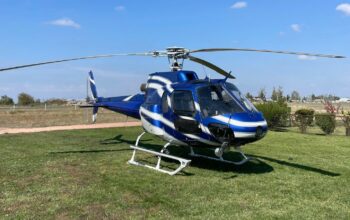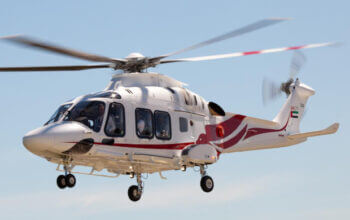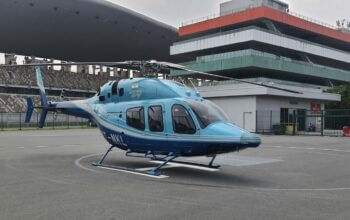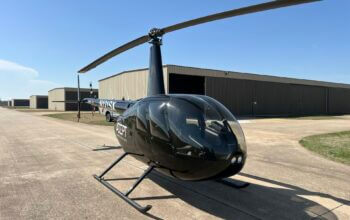Estimated reading time 20 minutes, 28 seconds.
The Canadian Department of National Defence is currently reviewing the contenders vying to replace the Canadian Forces’ venerable de Havilland CC-115 Buffalos, one of which is Viking Air own proposed next-generation version of the Buffalo.
It has been 64 years since the Department of National Defence (DND) assumed primary responsibility for federal air-based search and rescue (SAR) services, which today are complemented by assets from the Canadian Coast Guard, Royal Canadian Mounted Police, provincial and municipal police departments, and the Civil Air Search and Rescue Association (a volunteer network of aircraft pilots and owners, and SAR navigators and spotters). While DND often deploys other aircraft such as its Bell CH-146 (412CF) Griffon helicopters and Lockheed-Martin CC-130 Hercules fixed-wing transports its dedicated SAR platforms are the AgustaWestland CH-149 (AW101) Cormorant helicopter and the de Havilland CC-115 (DHC-5) Buffalo twin-engine turboprop.
The first Cormorants entered service in 2001; but the Buffalos, originally assigned a tactical transport role by the Royal Canadian Air Force, date to the mid-1960s. Re-tasked for SAR missions in 1975, the Buffalo fleet is now down to six aircraft, flown out of Canadian Forces Base (CFB) Comox, B.C., by 442 Transport and Rescue Squadron. The short take-off and landing capability and fundamental ruggedness and agility of the Buffalo make it well suited for the West Coast mountainous terrain and the offshore region (other regions are serviced by a mixture of Cormorants, Griffons and Hercules, although 442 Sqn has Cormorants, as well). However, given their dwindling number, age and maintenance difficulties (cost and scarcity of parts), the venerable Buffaloes are in need of replacements, which would be stationed with 442 Sqn at CFB Comox, 424 Transport and Rescue Squadron at CFB Trenton, Ont., 413 Transport and Rescue Squadron at CFB Greenwood, N.S., and possibly a northern base, too.
The Buffalos were considered for retirement 20 years ago and now cost an estimated $20 million Cdn annually to maintain. Defence Minister Peter MacKay is on record as saying there are no plans to keep them flying beyond 2015, but the debate about the 17 to 19 replacement aircraft, which would cost about $3 billion, has dragged on interminably, and there are indications that until a replacement is selected, West Coast SAR work would be assigned to some of the newer Hercules. In fact, this could happen before 2015, given that MacKay was advised in late September that keeping the Buffalos operational in the meantime would require new engines.
Mandatory Capabilities
The first statement of operational requirement (SOR) for the proposed new aircraft was issued in 2006, but it was clear from the outset that its focus was on potential aircraft, not on the SAR mission itself; the project ended up being stalled, partly due to bureaucratic infighting and indecision. In July 2009, the government official purchaser, Public Works and Government Services Canada (PWGSC), asked the National Research Council Canada (NRC) Flight Research Laboratory to review the SOR. The NRC team of test pilots and engineers concluded in their report six months later that the SOR was over-constrained, limiting the options for a program with a projected 30-year service life in some of the most hostile environments on the planet.
A key weakness of the SOR was the specification of an off the shelf aircraft, while also stating that modifications may be necessary. The team said that term should be avoided, unless no design changes are expected, because it has proven problematic in previous acquisitions and confers the invalid expectation that the level of effort by the vendor and DND to certify the aircraft will be minimal.
The NRC 54-page report also targeted an array of high-level mandatory capabilities set out in the original SOR, including an un-refuelled range of 1,699 nautical miles and a minimum, average level-flight cruising speed of 273 knots for up to 15 hours of mission time. While the range requirement would be an improvement over the Buffalo, it would fall short of the Hercules. As such, it was inconsistent with the stated core objective of the SOR of maintaining or improving the SAR level of service.
This all prompted an overhaul of the SOR, which was then the focus of a mid-August 2011 consultation meeting that PWGSC said was strictly reserved [for] properly registered industry representatives, so the government could review all proposed options and ensure the best possible SAR service to Canadians and best value for taxpayers. Bruno Potvin, contract manager for fixed-wing SAR (FWSAR) in the defence and major projects sector at PWGSC, also said the government was seeking industry opinions on alternate service delivery (ASD), which is code for possible private-sector SAR services or using more than one type of aircraft.
The Contenders
Since the outset of the FWSAR program, the main contenders have, like the Buffalo, been a pair of high-wing, twin-engine turboprops: the Casa C-295, built in Spain by a subsidiary of EADS Airbus Military; and the C-27J Spartan, built in Italy by Alenia Aeronautica, a division of the Finmeccanica conglomerate (which also owns AgustaWestland). The C-27J Spartan initially seemed headed for a sole-source contract, but the Seville-based builder of the C-295 managed to keep its aircraft in contention due to paralysis within Canada defence procurement bureaucracy.
When he appeared before the House of Commons standing committee on national defence, then EADS Canada chair Herve Garnier pointed out that Canadian EADS subsidiaries, including Eurocopter Canada and Composites Atlantic, directly employ 700 Canadians and draw from more than 460 Canadian suppliers, who have access to EADS global supply chain.
Antonio Rodriguez Barberan, senior VP commercial at Airbus Military, then told the committee that over 350 units of the C-295 and its CN-235 variant have accumulated more than 1.2 million flight hours. Calling it a solid, proven aircraft, with a robust landing gear to operate on soft and unpaved terrain, he said the C-295 is the only ramp- and sensor-equipped SAR platform in its class, with the highest reliability and lowest maintenance and operating costs.
The case for the Spartan was put to the committee mainly by Massimo Tarantola, chief operating officer of Alenia North America. While the company had another potential contender, one of its proven ATR regional turboprop models, Tarantola said it opted for the Spartan for Canada due to its unique military and operational requirements. Unstated was the prospect of also being able to use the C-27 tactically: The reliability and maintainability of the C-27J [has] been proven in tough and difficult operations in Afghanistan and various northern European countries. Key attributes include quick transition to search areas at speeds at least 50 knots higher than any other two-engine, potential competitors. However, he also said the model offers the kind of low-speed operation often required in mountainous terrain.
Discussions took an interesting turn when the Bell-Boeing partnership put up its unique V-22 Osprey tiltrotor aircraft. Bob Carrese, executive director of business development for the program, told Canadian Skies that the Osprey, which had its maiden flight in 1989, is the only aircraft capable of doing both the S and R parts of the SAR mission. It blends the high-speed, long-range capabilities of a fixed-wing platform with the manoeuvrability and vertical takeoff and landing attributes of a helicopter. He told the committee that, Integrating an appropriate number of these exceptional and proven aircraft into the Canadian Forces rescue community maximizes the level of SAR service by dramatically reducing time to rescue, while reducing total mission costs.
Proven in Afghanistan and other austere environments, after a rocky start that included a few high-profile crashes, more than 156 Ospreys are now flying with the U.S. military. In addition to its unique performance attributes, the V-22 provides a cost-efficient solution in a time of financial constraints, said Carrese. Total mission costs include the allocated costs of many complementary elements, in addition to direct operating costs of the platform itself. Tiltrotor technology greatly reduces the need for many of the support structures and systems, providing a substantially lower mission cost when compared with legacy partnerships of today. Also, the Osprey is capable of in-flight refuelling and evidently would be compatible with current Canadian tankers (a problem that has cropped up with the proposed F-35 fighter jet procurement see p.54, Canadian Skies, Sept-Oct 2011).
Meanwhile, Viking Air Ltd., based in Sidney, B.C. (near the southern tip of Vancouver Island), currently holds the type certificate on the Buffalo and contends that remanufactured and upgraded aircraft would be viable platforms. Viking is aggressively confident that it can support the current fleet while incorporating new technologies into a next generation platform: the DHC-5NG. About three years ago, Viking set out its plan and compared the DHC-5NG with the C-27J, which was developed from a 1963 design for the Fiat G.222 and is effectively a contemporary to the Buffalo design, which dates to 1962. Similarly, Viking said the DHC-5NG is a logical development of the original DHC-5 Buffalo. Incorporating new technology into proven airframes is nothing new, the company pointed out.
Viking said that while the C-27J engine, propeller and flight deck equipment is based on the Lockheed Martin C-130J, the DHC-5NG would use the latest commercial technologies. Its proposed total-systems upgrade would be centred on the engine/propeller combination from the Bombardier DHC-8 Q400. Canadian taxpayers will benefit greatly from using commercial equipment in terms of reliability, supportability and cost of operations, it claimed, noting that the Pratt & Whitney Canada PW150 engine, which would replace the current aircraft General Electric CT64-820-3 turbine, routinely flies more than 10,000 hours between overhauls and is in widespread use on the Q400s.
Viking president and CEO David Curtis was also quoted as saying the DHC-5NG would feature an integrated avionics and technology enhancement package with synthetic vision, forward-looking infrared imaging and night-vision-goggle capabilities, similar to those packages already being installed in its new Twin Otter Series 400 (see p.29, Canadian Skies, Sept-Oct 2011). Viking is prepared to restart production of the new Buffalo at its plants in Calgary, Alta., and at the Victoria International Airport in Sidney, leveraging the engineering, research and development done on the original model.
Said Curtis, in an open letter: Viking has already received serious interest from governmental agencies around the world and is cognizant of the growing demand for the launch of new-production DHC-5 Buffalo aircraft. By upgrading and modernizing the [CC-115] fleet and incorporating new-build Buffalo aircraft, manufactured and supported in Canada, the cost savings over the introduction of a completely new type is huge.
The ASD Option
As for the options opened by ASD, the mid-August industry day organized by PWGSC attracted not only potential prime contractors, but also an array of companies that ordinarily would not be players in a major Crown project. Prominent among them was Toronto, Ont., based Field Aviation Co. Inc., self-described aircraft modifiers to the world. In an interview with Canadian Skies, David Jensen, VP of business development for Field Aviation, recalled a similar industry day organized by the government two years earlier. That a couple of hours of time I’ll never get back, he laughed, recalling general industry dismay at how the FWSAR program was pitched at the time. The feedback this time was more positive. Jensen said it was clear the military was now leaning very heavily on the NRC review. Whatever the NRC had written will be considered gospel, really, for assessing technical compliance.
Field, however, will not be putting forward a modified, upgraded Dash 8 similar to the model it delivered to the Icelandic coast guard (ICG) earlier this year. The key element there was an extensive cockpit upgrade, developed in collaboration with Universal Avionics of Tucson, Ariz. Designed for Bombardier/de Havilland 100/200/300 series that dates back to the 1980s, the upgrade replaces more than 30 mechanical indicators from the instrument panel with five lighter and more-reliable flat-panel displays. ICG director general Georg Lárusson said this would improve the working environment for the pilots and facilitate operation of the aircraft in its various mission roles, including SAR operations.
Jensen said because a Dash 8 or any other civil design is not an option for the FWSAR program, as defined, Field was not married to the Dash 8 by any stretch. He said the ASD option of a multi-type fleet could mean that not all aircraft would need a rear ramp, despite DND disinterest at the outset in deviating from its initial short list: the C-27J, C-295 and possibly the C-130. He said when Field became involved in the first Australian Coastwatch program, part of its initial assessment was, What the cheapest and best way to do this? The company considered a range of aircraft from Beechcraft King Airs up to aircraft bigger and faster than Dash 8s, including jets. From the way the Australians had defined their requirement, it came down to a twin turboprop carrying the biggest radar available being the right answer a Dash 8. We’re quite willing to do a white sheet’ assessment again [for Canada]. Maybe the answer is a C-130, in which case maybe there is some part of that that Field Aviation [can] do. We’ve got good experience on C-130s and we have experience operating fleets for the military in other roles.
Jensen also said the ASD option was politically driven into the project shortly before the August meeting, possibly in a bid to keep costs down as the government tackles its deficit. That opens up possibilities such as company-owned and operated aircraft, perhaps with one or two RCAF crewmembers, or possibly governmentally owned but privately operated aircraft. I think all of those things are on the table, said Jensen, adding that they may get thrown off the table for practical reasons.
In the two months since the August meeting, the government has been flooded with a welter of proposals for ASD. They’re going to grind through that . . . and there will be a request for proposals, stated Jensen. I would be surprised to see it before the end of the year, but somewhere through this winter season
. . . is what I would expect.
Asked whether the government plan to retire the Buffalos by 2015 was realistic, he replied that it would be interesting to see how they can put that into effect.
Having never finished an engineering degree (probably a service to aviation, Ken says), Ken Pole has had a lifelong passion for things with wings. The longest-serving continuous member of the Parliamentary Press Gallery in Ottawa, Ont., he has written about aerospace in all its aspects for more than 30 years. When not writing, he an avid sailor, diver and photographer.















